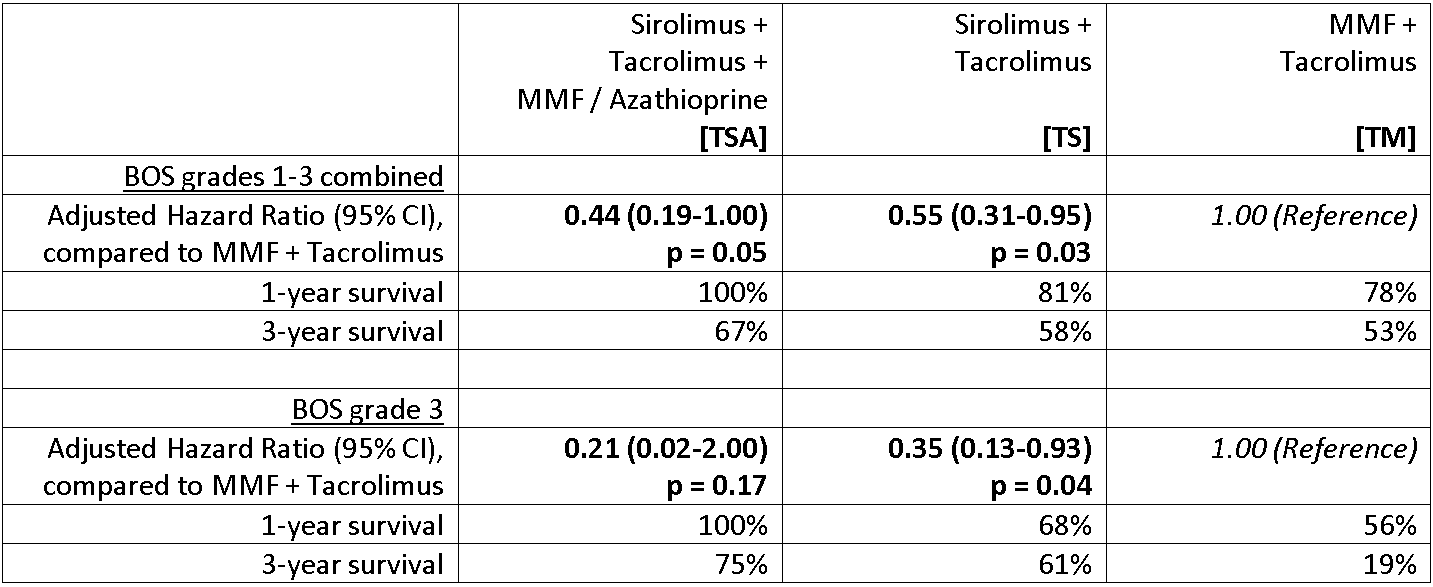Sirolimus Plus Tacrolimus Immunosuppression, with or without Mycophenolate Mofetil, May Improve Survival after Bronchiolitis Obliterans Syndrome in Lung Transplant Patients
University of Maryland School of Medicine, Baltimore, MD
Meeting: 2020 American Transplant Congress
Abstract number: 188
Keywords: Immunosuppression, Lung transplantation, Rejection, Survival
Session Information
Session Name: Living in the Real World: Decision Making and Outcomes After Lung Transplant
Session Type: Oral Abstract Session
Date: Saturday, May 30, 2020
Session Time: 3:15pm-4:45pm
 Presentation Time: 3:39pm-3:51pm
Presentation Time: 3:39pm-3:51pm
Location: Virtual
*Purpose: There are very few ways to improve survival after bronchiolitis obliterans syndrome (BOS), the leading cause of death in lung transplant patients. Two long-term studies have found that prophylactic sirolimus + tacrolimus immunosuppression early after lung transplantation is associated with significantly improved survival and lower BOS risk compared to the traditional mycophenolate mofetil (MMF) + tacrolimus regimen, but among patients with BOS, data comparing survival between regimens are lacking.
*Methods: This study included lung transplant patients with BOS in the U.S. Scientific Registry for Transplant Recipients (SRTR), transplanted from May 2005-August 2016 and initially receiving traditional maintenance immunosuppression (tacrolimus/cyclosporine + MMF/azathioprine) and induction with basiliximab, daclizumab, antithymocyte globulin, alemtuzumab, or no induction. Patients missing data on BOS grade (1-3) or immunosuppression following BOS diagnosis were excluded. Survival was compared between BOS patients receiving tacrolimus + sirolimus [TS], tacrolimus + sirolimus + antimetabolite (MMF/azathioprine) [TSA], or tacrolimus + MMF [TM], based on Kaplan-Meier estimates and Cox regression adjusting for demographic and clinical factors, including transplant center-specific survival among BOS patients.
*Results: Combining BOS grades 1-3 without adjustment, 1-year survival and median [interquartile range] survival times by treatment group were, TSA: 100%, 4.5 [2.9-6.5] years, n=14; TS: 81%, 4.4 [1.6- -] years, n=37; TM: 78%, 3.5 [1.3-7.0] years, n=471. The groups had different distributions of BOS grades (p=0.004); prevalence of Grade 3 BOS at baseline was 36% in TSA, 51% in TS, and 27% in TM. Each group had patients from over 10 different centers. In adjusted analysis, TSA (HR=0.44, p=0.05) and TS (HR=0.55, p=0.03) were associated with better survival than TM. Effect sizes were larger when restricting to BOS Grade 3 patients; TSA again showed a trend towards the most favorable survival (HR=0.21, p=0.17) and TS (HR=0.35, p=0.04) also showed better survival, compared to TM.
*Conclusions: Maintenance immunosuppression combining sirolimus and tacrolimus may significantly improve survival in patients with BOS (especially Grade 3). Adding MMF or azathioprine to this combination appears promising, particularly for short-term survival in these patients with a high mortality rate, while being attentive to risks of possible over-immunosuppression with this strategy combining all 3 drug classes.
To cite this abstract in AMA style:
Wijesinha M, Terrin M, Griffith B, Iacono A. Sirolimus Plus Tacrolimus Immunosuppression, with or without Mycophenolate Mofetil, May Improve Survival after Bronchiolitis Obliterans Syndrome in Lung Transplant Patients [abstract]. Am J Transplant. 2020; 20 (suppl 3). https://atcmeetingabstracts.com/abstract/sirolimus-plus-tacrolimus-immunosuppression-with-or-without-mycophenolate-mofetil-may-improve-survival-after-bronchiolitis-obliterans-syndrome-in-lung-transplant-patients/. Accessed December 16, 2025.« Back to 2020 American Transplant Congress

